Abstract
Three tests are routinely done to assess blood status of selenium in cattle: serum selenium, whole blood selenium, and glutathione peroxidase. The objective of this study was to compare the various analytical methods for determining blood selenium status in groups of mature cows and beef calves. Twenty to 30 blood samples per herd were collected from 8 beef herds in central Alberta and 1 dairy in Alberta herd twice a year from the spring of 1992 through the fall of 1995, and once from 185 spring calves in 2 beef herds in Saskatchewan. Serum and whole blood samples were submitted to 1 laboratory and whole blood samples were submitted to a 2nd laboratory. Samples for glutathione peroxidase determinations were submitted to a 3rd laboratory. Pearson's correlation coefficients and Cohen's kappa were calculated for each possible comparison among the different measures. The best agreement was observed between serum and whole blood analysis within Laboratory A. The remaining comparisons reflected poor agreement. Comparison of herd-level assessment resulted in better agreement than comparison of individual sample results among laboratories and procedures for all combinations tested. Serum selenium analysis was the only laboratory procedure for which external reference material was utilized. Serum selenium, whole blood selenium, and glutathione peroxidase measure different compartments of the blood selenium pool. The time frame of interest, supplementation practices, and the stability of recent dietary intake determine the optimum assessment method for individual animals or herds. Determination of the serum status or of blood selenium is more consistently measured at the herd-level than for individual samples.
Full text
PDF
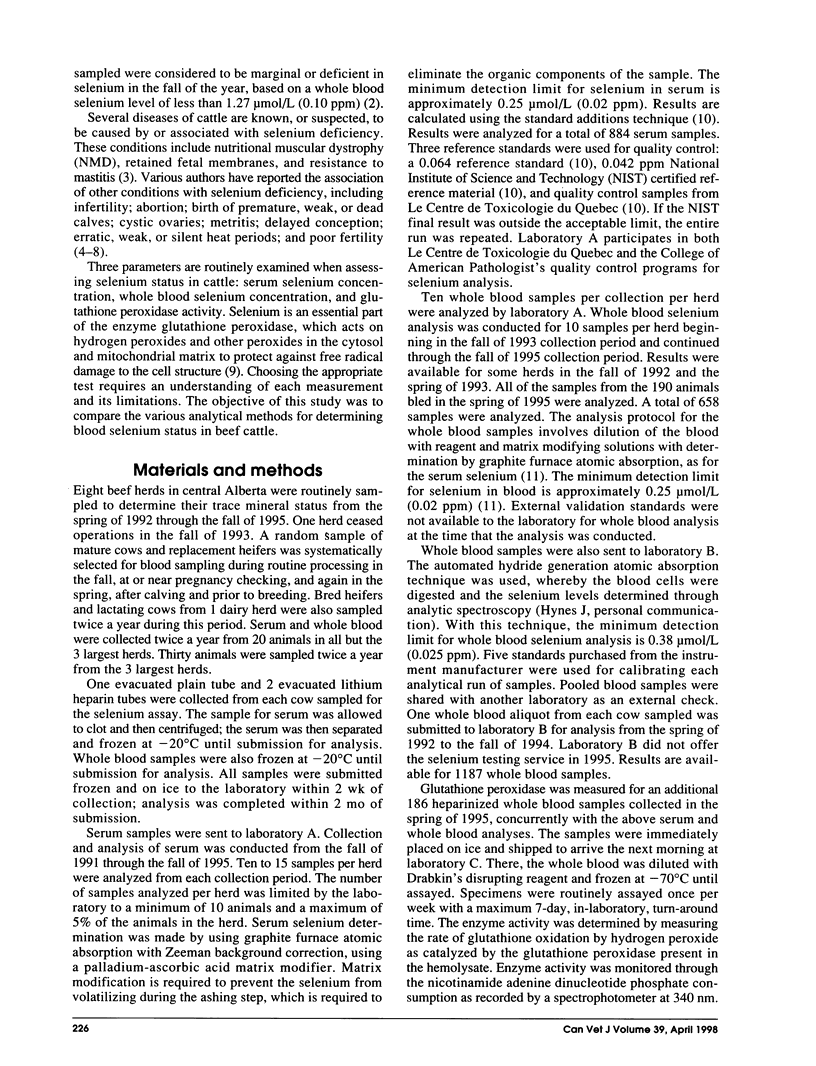
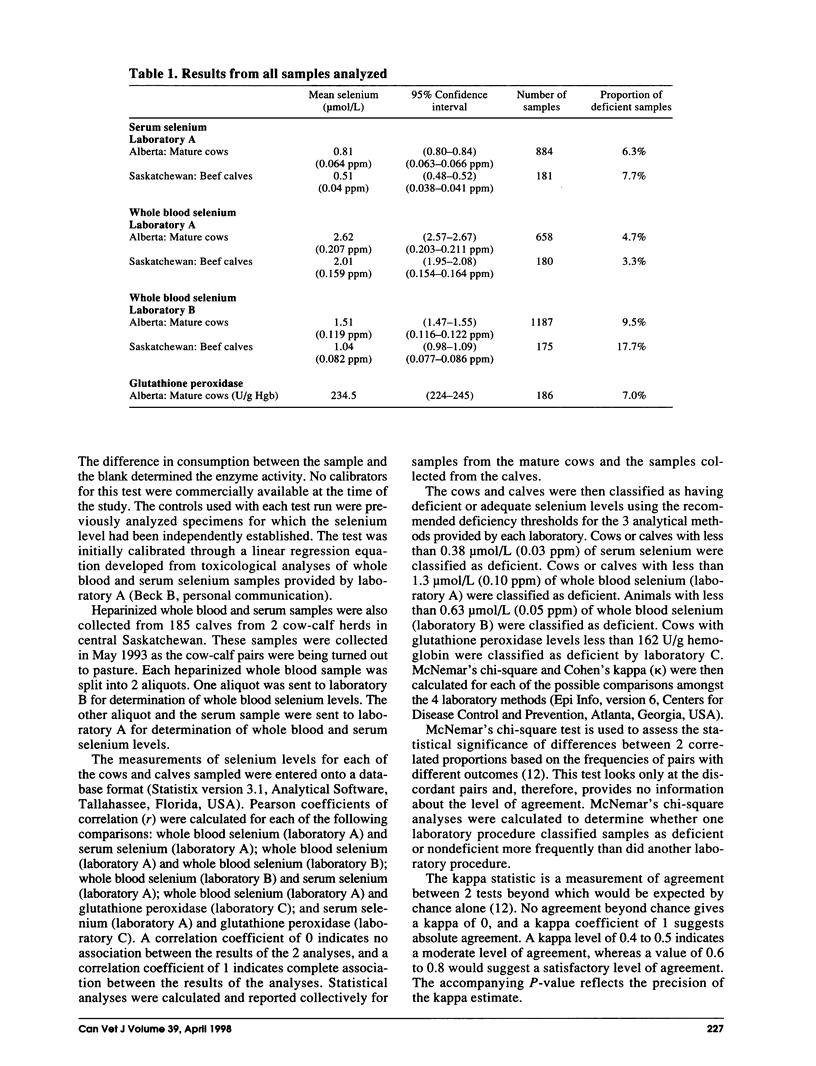
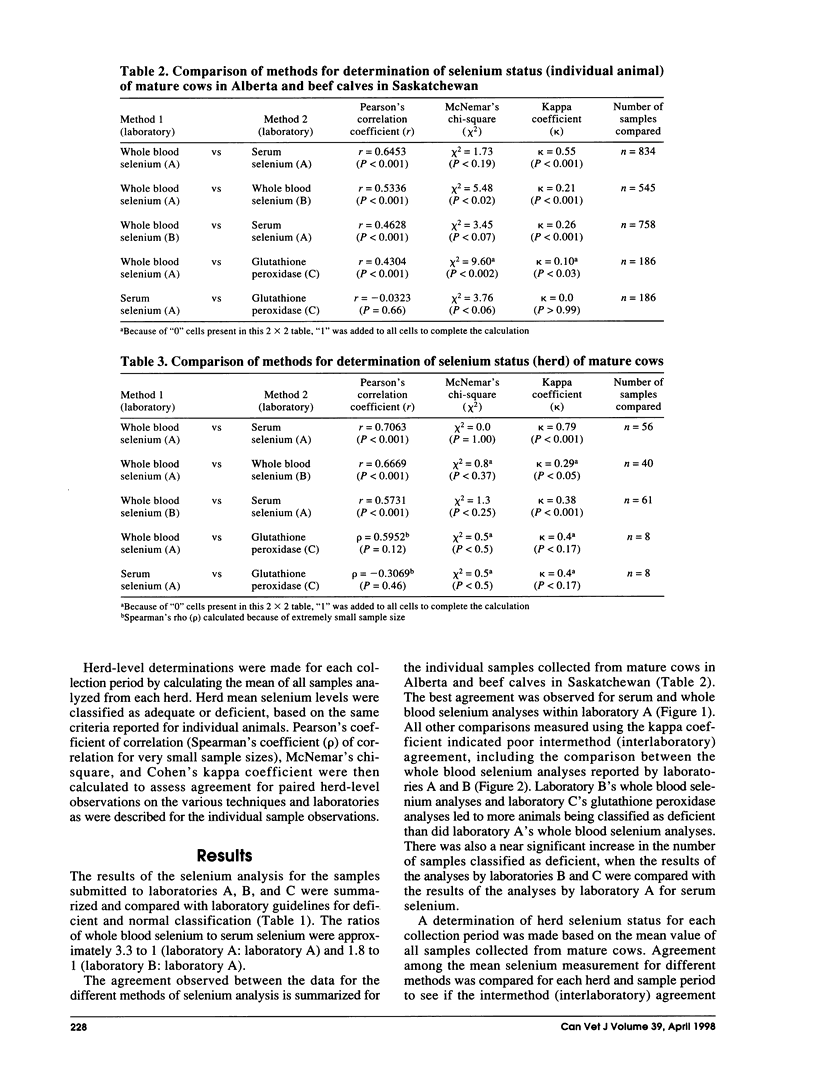
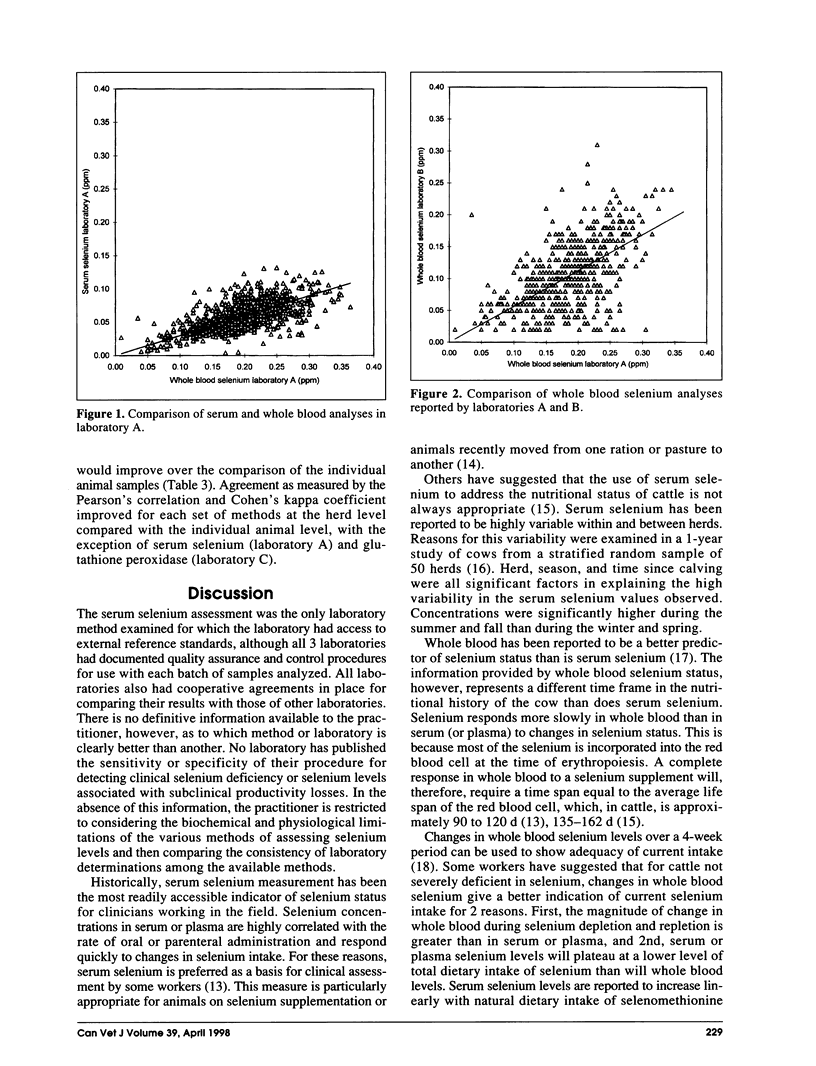
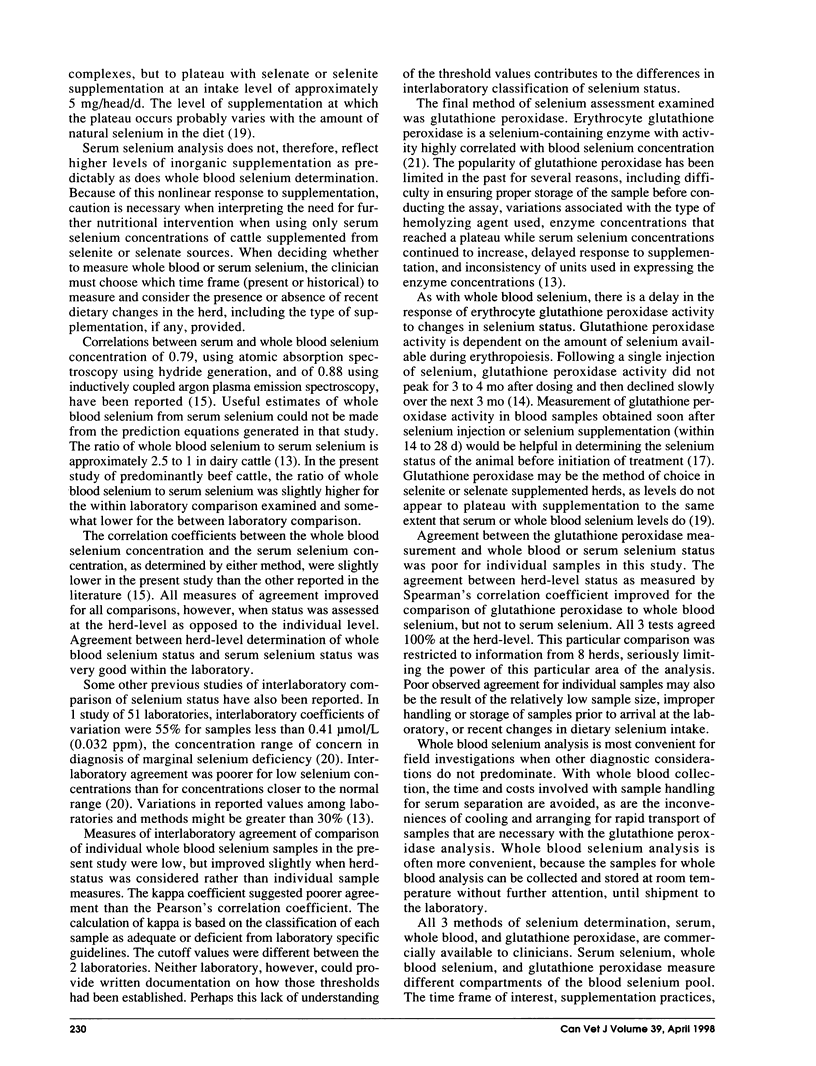
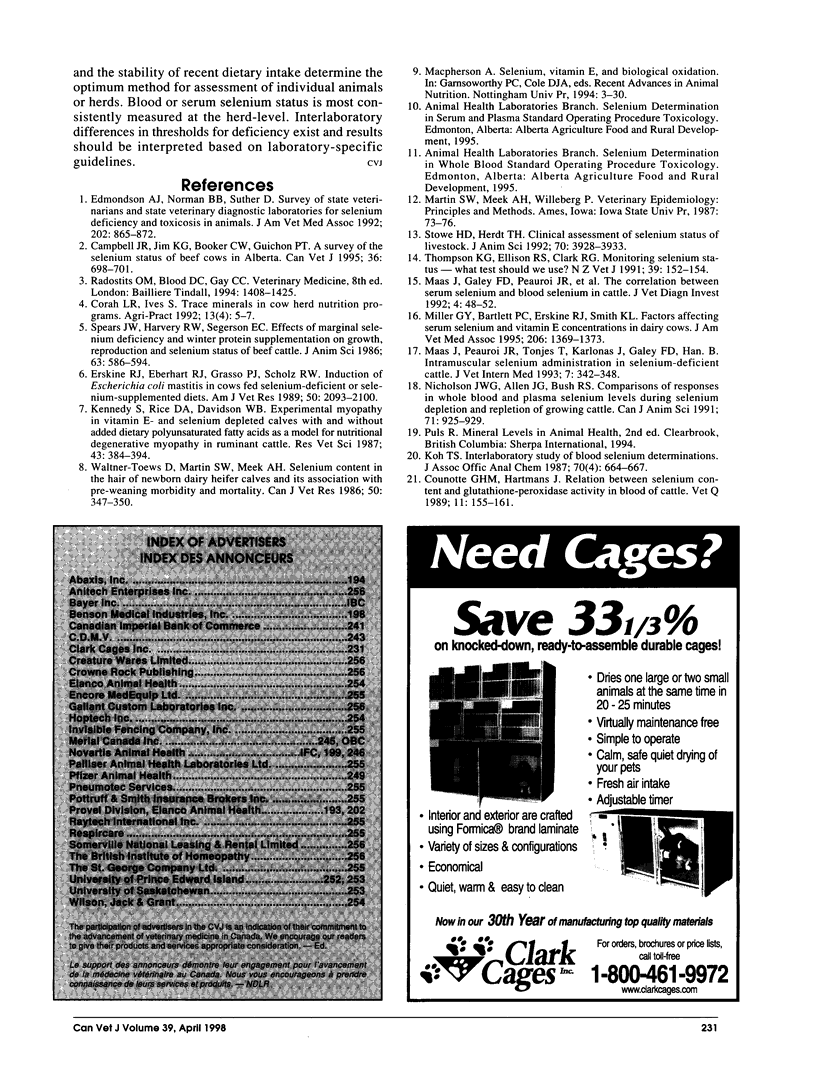
Selected References
These references are in PubMed. This may not be the complete list of references from this article.
- Campbell J. R., Jim G. K., Booker C. W., Guichon P. T. A survey of the selenium status of beef cows in Alberta. Can Vet J. 1995 Nov;36(11):698–702. [PMC free article] [PubMed] [Google Scholar]
- Counotte G. H., Hartmans J. Relation between selenium content and glutathione-peroxidase activity in blood of cattle. Vet Q. 1989 Jul;11(3):155–160. doi: 10.1080/01652176.1989.9694214. [DOI] [PubMed] [Google Scholar]
- Edmonson A. J., Norman B. B., Suther D. Survey of state veterinarians and state veterinary diagnostic laboratories for selenium deficiency and toxicosis in animals. J Am Vet Med Assoc. 1993 Mar 15;202(6):865–872. [PubMed] [Google Scholar]
- Erskine R. J., Eberhart R. J., Grasso P. J., Scholz R. W. Induction of Escherichia coli mastitis in cows fed selenium-deficient or selenium-supplemented diets. Am J Vet Res. 1989 Dec;50(12):2093–2100. [PubMed] [Google Scholar]
- Kennedy S., Rice D. A., Davidson W. B. Experimental myopathy in vitamin E- and selenium-depleted calves with and without added dietary polyunsaturated fatty acids as a model for nutritional degenerative myopathy in ruminant cattle. Res Vet Sci. 1987 Nov;43(3):384–394. [PubMed] [Google Scholar]
- Koh T. S. Interlaboratory study of blood selenium determinations. J Assoc Off Anal Chem. 1987 Jul-Aug;70(4):664–667. [PubMed] [Google Scholar]
- Maas J., Galey F. D., Peauroi J. R., Case J. T., Littlefield E. S., Gay C. C., Koller L. D., Crisman R. O., Weber D. W., Warner D. W. The correlation between serum selenium and blood selenium in cattle. J Vet Diagn Invest. 1992 Jan;4(1):48–52. doi: 10.1177/104063879200400111. [DOI] [PubMed] [Google Scholar]
- Maas J., Peauroi J. R., Tonjes T., Karlonas J., Galey F. D., Han B. Intramuscular selenium administration in selenium-deficient cattle. J Vet Intern Med. 1993 Nov-Dec;7(6):342–348. doi: 10.1111/j.1939-1676.1993.tb01029.x. [DOI] [PubMed] [Google Scholar]
- Miller G. Y., Bartlett P. C., Erskine R. J., Smith K. L. Factors affecting serum selenium and vitamin E concentrations in dairy cows. J Am Vet Med Assoc. 1995 May 1;206(9):1369–1373. [PubMed] [Google Scholar]
- Spears J. W., Harvey R. W., Segerson E. C. Effects of marginal selenium deficiency and winter protein supplementation on growth, reproduction and selenium status of beef cattle. J Anim Sci. 1986 Aug;63(2):586–594. doi: 10.2527/jas1986.632586x. [DOI] [PubMed] [Google Scholar]
- Stowe H. D., Herdt T. H. Clinical assessment of selenium status of livestock. J Anim Sci. 1992 Dec;70(12):3928–3933. doi: 10.2527/1992.70123928x. [DOI] [PubMed] [Google Scholar]
- Thompson K. G., Ellison R. S., Clark R. G. Monitoring selenium status - what test should we use? N Z Vet J. 1991 Dec;39(4):152–154. doi: 10.1080/00480169.1991.35685. [DOI] [PubMed] [Google Scholar]
- Waltner-Toews D., Martin S. W., Meek A. H. Selenium content in the hair of newborn dairy heifer calves and its association with preweaning morbidity and mortality. Can J Vet Res. 1986 Jul;50(3):347–350. [PMC free article] [PubMed] [Google Scholar]


